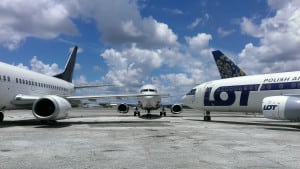Latest News
[Via Satellite 10-05-2015] There’s a shift taking place in the In-Flight Entertainment and Connectivity (IFEC) provider marketplace, one that you could see at this year’s Airline Passenger Experience (APEX) Expo in Portland, Ore. “What’s changed from last year? Every satellite operator is here at this show because we are buying so much capacity,” David Bruner, vice president of global communications services for Panasonic Avionics Corporation told Via Satellite during an interview at APEX, last week. The Panasonic executive was referring to the heavy presence of satellite operators, including big names such as Inmarsat, Intelsat and SES, that are popping up at shows like APEX or the Global Connected Aircraft Summit, as space-based technology looks to enable the evolving IFC landscape, which has traditionally been facilitated by terrestrial, Air-to-Ground (ATG) tech.
As an example, Panasonic released major announcements with two companies versed in delivering satellite solutions in the last two months alone: the first being the conclusion of its acquisition of ITC Global in August, a provider of satellite communication services for the energy, mining, and maritime markets. The most recent agreement is with OmniAccess, a supplier of integrated communications solutions to super yachts and cruise ships, which the company has contracted to participate in the development of Panasonic’s “Extreme High Throughput” (XTS) satellite network. Through this agreement OmniAccess plugs into Panasonic’s existing capacity, currently contracted capacity and the future XTS satellite network
“The ITC Global business was about two-thirds the size of our network. This most recent announcement last week with OmniAccess, which provides service to yachts and cruise ships, they were about a third of our size. So ITC together with OmniAccess doubled the buying power and operating network size of our aviation business. That really helps us as we go forward. We’re growing quickly, at about 30 to 40 percent per year. With those other two businesses growing at a similar rate, collectively, now we’re twice the size and growing at 100 percent per year,” said Bruner.
Previously, Panasonic announced major commitments to two Intelsat Epic satellites and Eutelsat’s 172B satellite. The company is also in the process of contracting for XTS High Throughput Satellite (HTS) capacity, which promises to up performance to its customers in aeronautical, energy, maritime, and mining.
The company is following much in the vein of Gogo, who’s 2Ku program — now flying on Gogo’s own test aircraft and expected to launch at the end of this year — is looking to make the move to satellite systems in addition to their already successful ATG network.
“An air-to-ground solution by itself is no longer competitive,” Gogo CEO Michael Small said at the UBS Global Media and Communications Conference last year. “It used to be that regional coverage was competitive in the wireless business on the ground and then all of a sudden it had to be national coverage. If connectivity is transformative to aviation you can’t afford to have it most of the time; you have to have it all of the time. So a high percentage of planes will be satellite [in the future].”
As IFC providers look to make the switch to satellite and hybrid solutions to enable aircraft connectivity, newer satellite operators are looking to feel out the arena to see what they have to offer the burgeoning vertical.
“We, Panasonic, are spending a lot of time with satellite manufacturers and figuring out what technology is coming. Helping them understand the mobility market. There’s a lot of new stuff coming along that will really help the less dense areas and add flexibility to future payloads,” said Todd Hill, director of global communications services, products and capacity at Panasonic Avionics. And this mutual education of each other’s roles in the future IFC ecosystem is what many satellite operators new to shows like APEX as well as the IFE&C arena are looking to establish.
“What we’re trying to do here at the show is get that word out, let people know we’re the satellite operator that provides a lot of our resellers with the capacity that runs the Internet on the planes, and also try to educate ourselves at the show and understand what the needs are and where the understandings start and stop at the end user level all the way up through the chain,” Arnie Christianson, senior program manager of data mobility at SES, told Via Satellite.
SES currently provides wideband, Ku-band and C-band services, among others, and has plans to launch three new HTS satellites in the next two years aimed at servicing and supporting the mobility market — SES-12, 14 and 15.
While the company has been servicing aviation in the government sector, where the return channels are often the most important aspect of connectivity, SES is looking to examine the new developments in the commercial market, which Christianson said is the “exact opposite” of the government sector, where the download to the plane is the most important piece.
“It helps us to know the entire ecosystem from the end user on the plane to the end user on the satellite, because if we understand the behaviors, the relationships that pull all the way through that, it helps us to design a better system. If we know that specific antennas are being used to test for specific throughputs, we might have some insights into that. We can work with our resellers to provide them with metadata, we can exchange information, the more we talk the better it is, because at the end of it people on planes are expecting to have a home-type experience when they’re sitting on the plane, and we’re about to get there,” said Christianson who, much like Panasonic, sees HTS as the way to ultimately provide fast, reliable IFC to aircraft. He expects HTS will form the background of the network that resellers will use.
“We’re at that point in technology. High throughput satellites definitely will do that,” said Christianson.
Get the latest Via Satellite news!
Subscribe Now